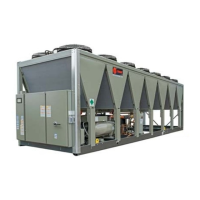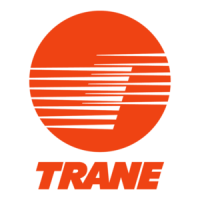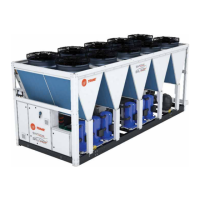RLC-SVX19G-GB
100
4 UNT-PRC002-GB
Technical Data
FWD 08 12 20 30 45
Power supply (V/Ph/Hz) 230/1/50
Capacities
Cooling capacity on water (1) (kW) 5,2 8,3 15 18,8 30,1
Heating capacity on water (2) (kW) 6,3 11,9 18,9 20,9 38,2
Fan motor (type) 2 x direct drive centrifugal
Fan power input (3) (kW) 0,23 0,46 0,65 1,04 1,51
Current amps (3) (A) 1,1 2,2 3,1 4,7 5,5
Start-up amps (A) 3,2 5,5 9,3 14,1 16,5
Air flow
minimum (m
3
/h) 490 980 1400 1800 2700
nominal (m
3
/h) 820 1650 2300 3000 4500
maximum (m
3
/h) 980 1970 2600 3600 5400
Main coil
Water entering/leaving connections (type) ISO R7 rotating female
(Dia) 3/4" 3/4" 1 1/2" 1 1/2" 1 1/2"
Electric heater (accessory for blower only)
Electric power supply (V/Ph/Hz) 230/1/50 230/1/50 or 400/3/50 400/3/50 400/3/50 400/3/50
Heating capacity (kW) 2/4 8 10 12 12
Hot water coil (accessory for blower only)
Heating capacity (4) (kW) 6,3 12 17,4 22,4 34,5
G2 filter (filter box accessory)
Quantity 2 2 2 2 2
Dimensions ( LxWxth) (mm) 386x221x8 486x271x8 586x321x8 586*421*8 586*621*8
G4 filter (filter box accessory)
Quantity - 2 2 2 2
Dimensions ( LxWxth) (mm) - 486x264x48 586x314x48 586*414*48 586*614*48
Condensate pump (accessory) (type) Centrifugal
Water flow - lift height (l/h - mm) 24 - 500
Not available for FWD30 and FWD45
Sound level (L/M/H speed)
Sound pressure level (5) (dB(A)) 36/40/43 38/41/44 46/50/53 47/52/57 47/52/58
Sound power level (5) (dB(A)) 46/50/53 48/51/54 56/60/63 57/62/67 57/62/68
Unit dimensions
Width x Depth (mm) 890 x 600 1090 x 710 1290 x 820 1290 x 970 1290 x 1090
Height (mm) 250 300 350 450 650
Shipped unit dimensions
Width x Depth (mm) 933 x 644 1133 x 754 1333 x 864 1333 x 1008 1333*1133
Height (mm) 260 310 360 460 660
Weight (kg) 32 46 61 76 118
Colour galvanised steel
Recommended fuse size
Unit alone (aM/gI) (A) 8/16 8/16 8/16 8/25 8/25
Unit with electric heater (gI) (A) 16 (2kW),25 (4kW) 40 (230V),3*16 (400V) 3*20 3*25 3*25
(1) Conditions: Water entering/leaving temperature: 7/12 °C, Air inlet temperature 27/19°C DB/WB - Nominal air flow
(2) Conditions: Water entering/leaving temperature: 50/45 °C, Air inlet temperature 20°C DB - Nominal air flow
(3) At high speed with nominal air flow.
(4) Water entering/leaving temperature 90/70 °C, air inlet temperature 20 °C DB, Nominal air flow.
(5) A rectangular glass wool duct 1m50 long is placed on the blower.The measurement is taken in the room containing the blower unit.
Heat exchanger operating limits:
FWD:
*water temperature: max 100° C
*absolute service pressure: min 1 bar/max 11 bars
Accessories - Hot water coil:
*water temperature: min. +2° C/max. 100° C
*absolute service pressure: min 1 bar/max 11 bars
Chilled Water Piping Recommendations
Water Treatment
In the evaporator the following material are in contact
with water:
• Water boxes are made of cast iron (GJL250 EN-code)
• Tube plates are made of steel (P265GH code)
• Tubes are made of copper
• Turbulators when present in evaporator tubes are
made of phosphorous brass.
When the unit is supplied with hydraulic module, the
following additional materials are in contact with water:
• Pump frame and connections are made of cast iron
• Water pipes are made of iron
• Pipe sealings are made of EPDM rubber (ethylene
propylene diene monomer rubber)
• Pump sealings are made of silicon carbide
• Strainer is made of stainless steel
Notice!
Dirt, scale, products of corrosion, and other foreign
material will adversely affect heat transfer between the
water and system components. Foreign matter in the
chilled-water system can also increase pressure drop
and consequently, reduce water flow. Proper water
treatment must be determined locally, depending on the
type of system and local water characteristics.
Neither salt nor brackish water is recommended for use
in Trane air-cooled chillers. Use of either will lead to an
unpredictably shorter life cycle. Trane encourages the
employment of a reputable water treatment specialist,
familiar with local water conditions, to assist in this
determination and in the establishment of a proper water
treatment program.
CAUTION! If using an acidic commercial flushing
solution, construct a temporary bypass around the
unit to prevent damage to internal components of
the evaporator. Trane assumes no responsibility for
equipment failures which results from untreated or
improperly treated water or saline or brackish water.
If calcium chloride is used for water treatment, an
applicable corrosion inhibitor must also be used. Failure
to do so may result in damage to system components.
Do not use untreated or improperly treated water.
Equipment damage may occur.
Notice: Coil Damage!
Failure to follow instructions below could result in
freecooling coil freeze. For units with free-cooling option,
introduction of uninhibited water into the system is not
recommended, as it could lead to internal corrosion and
risk of coil freeze. To avoid free-cooling coil damage:
• If the building loop needs to be charged with water for
testing purposes, isolate free-cooling coils by closing
free-cooling service shut-off valve and modulating
valve.
• Completely drain any water inadvertently introduced
into the system, and replace with glycol fluid as
required for the free-cooling system.
• If water was introduced for hydronic testing, and was
not immediately replaced with glycol solution, a glycol
(freeze inhibitor) solution must be introduced to the
free-cooling system/coils for any long term storage.
Evaporator Piping
Evaporator water connections are grooved.
Thoroughly flush all water piping to the unit before
making the final piping connections to the unit.
Components and layout will vary slightly, depending on
the location of connections and the water sources (see
figure Typical RTAF water piping figure).
An air vent is located on top of the evaporator at the
chiller water outlet. Be sure to provide additional air
vents at the highest points in the piping to remove air
from the chilled water system. Install necessary pressure
gauges to monitor the entering and leaving chilled water
pressure.
Provide shut off valves in lines to the gauges to isolate
them from the system when they are not in use. Use
rubber vibration eliminators to prevent vibration
transmission through the water lines.
If desired, install thermometers in the lines to monitor
entering and leaving water line to control water flow
balance. Install shutoff valves on both the entering and
leaving water lines so that the evaporator can be isolated
for service.
CAUTION! The chilled-water connections to the
evaporator are to be “grooved pipe” type connections.
Do not attempt to weld these connections, because the
heat generated from welding can cause microscopic
and macroscopic fractures on the cast iron water boxes
that can lead to premature failure of the water box. An
optional grooved pipe stub and coupling is available for
welding on flanges.
To prevent damage to chilled-water components, do not
allow evaporator pressure (maximum working pressure)
to exceed 10 Bar. The maximum service pressure
depends on free cooling type and potential pump
package option. The value of max service pressure is
indicated on unit nameplate.
A pipe strainer must be installed in the entering water
line. Failure to do so can allow waterborne debris to
enter the evaporator.
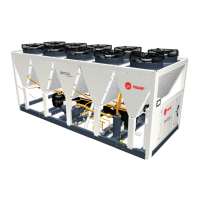
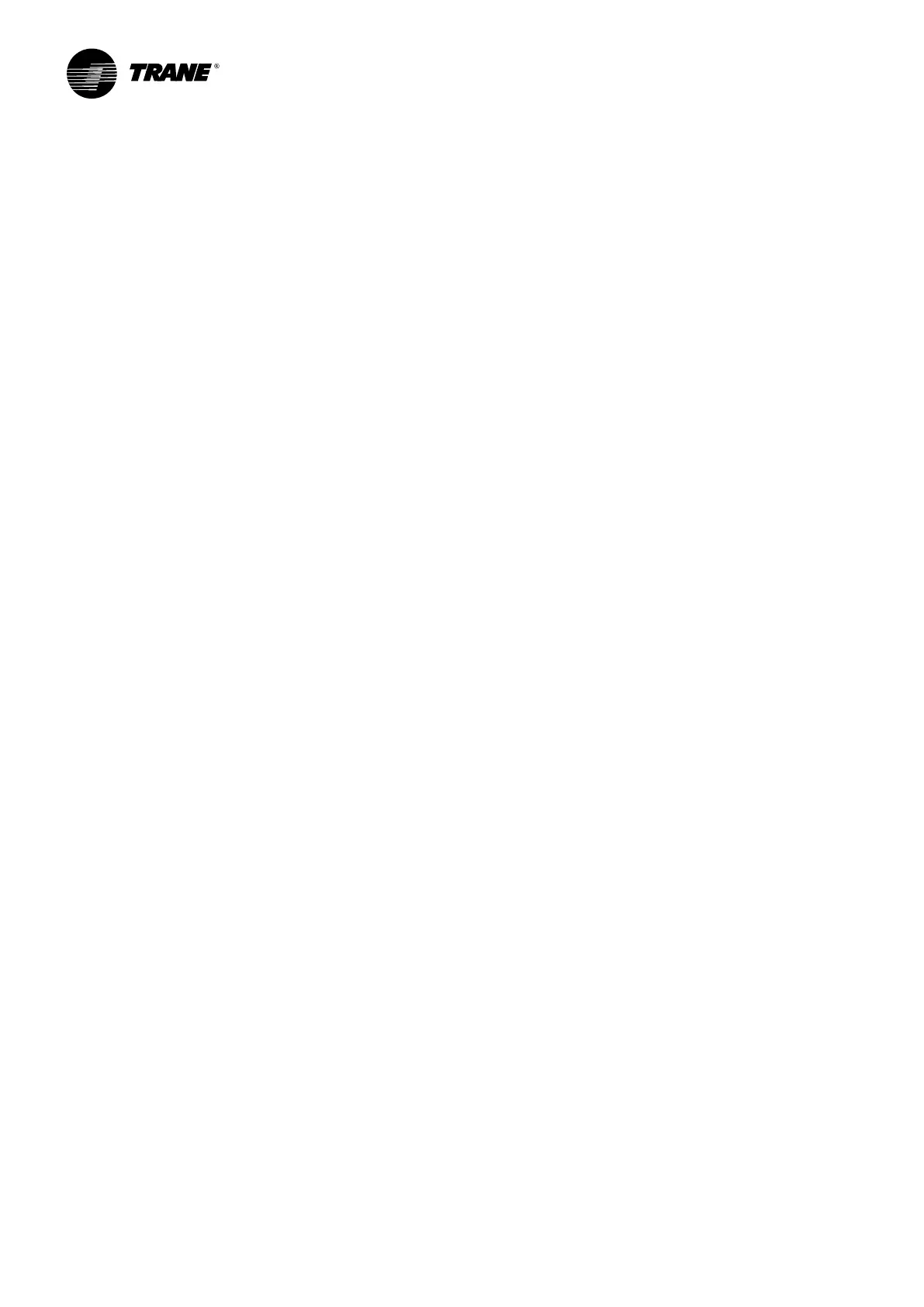